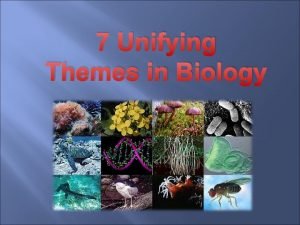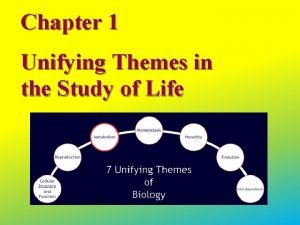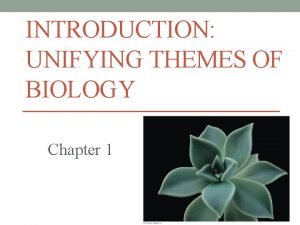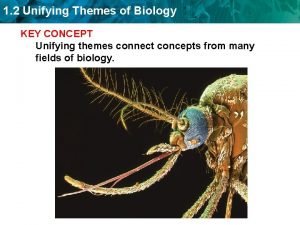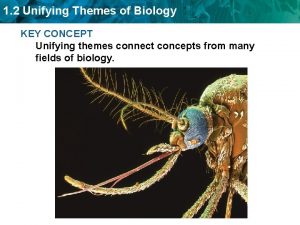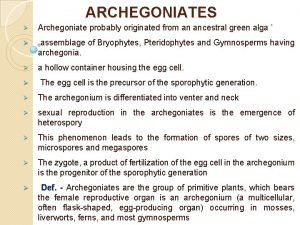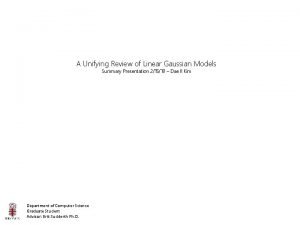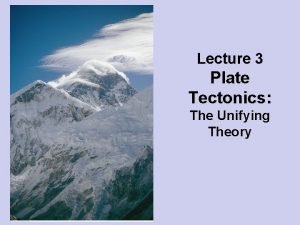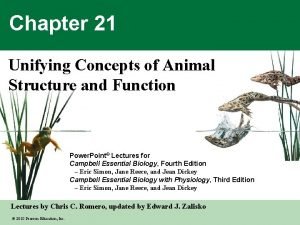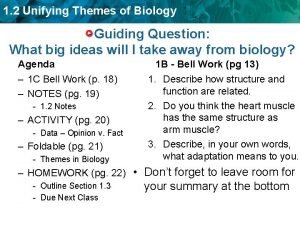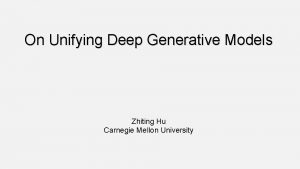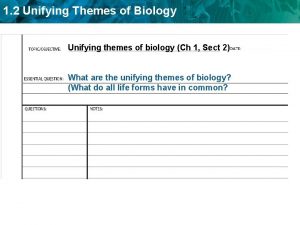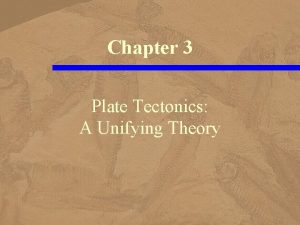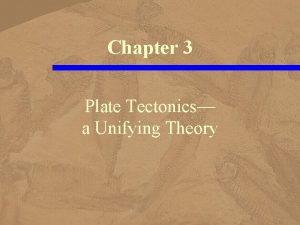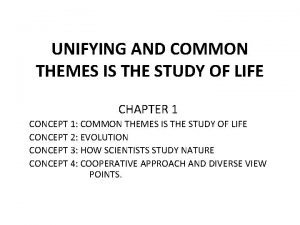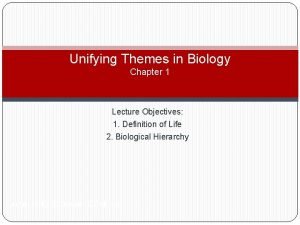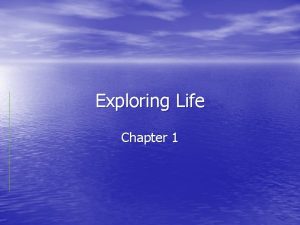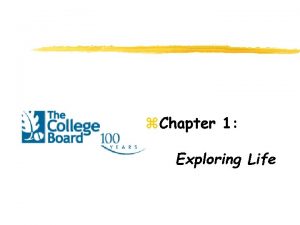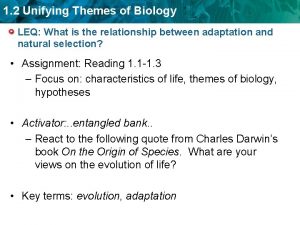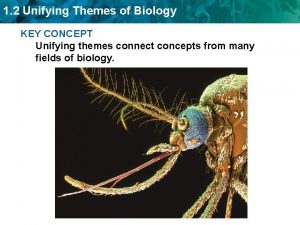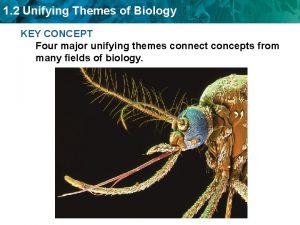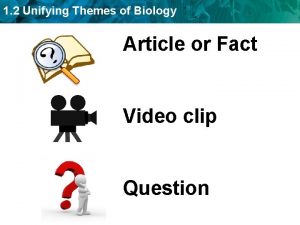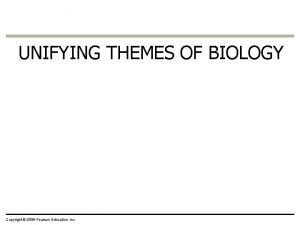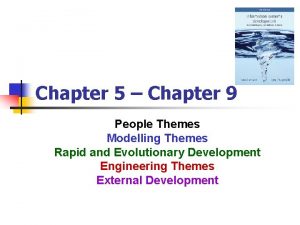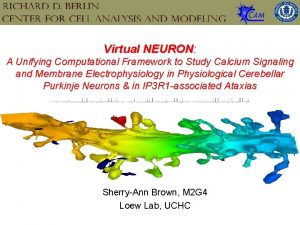Chapter 1 Unifying Themes in the Study of






























- Slides: 30

Chapter 1 Unifying Themes in the Study of Life


• Life defies a simple, one-sentence definition • Life is recognized by what living things do. Think about it… does this make sense to you? What is meant by the phrase, …what living things do? Copyright © 2008 Pearson Education, Inc. , publishing as Pearson Benjamin Cummings

Fig. 1 -3 Order Response to the environment Evolutionary adaptation Regulation Energy processing Reproduction Growth and development

Concept 1. 1: Unifying themes connect the concepts of biology • Biology consists of more than memorizing factual details • Themes help to organize biological information Copyright © 2008 Pearson Education, Inc. , publishing as Pearson Benjamin Cummings

Evolution, the Overarching Theme of Biology • Evolution makes sense of everything we know about living organisms • Organisms living on Earth are modified descendants of common ancestors Copyright © 2008 Pearson Education, Inc. , publishing as Pearson Benjamin Cummings

Theme 1: New properties emerge at each level in the biological hierarchy • Life can be studied at different levels from molecules to the entire living planet • The study of life can be divided into different levels of biological organization The biosphere Cells 10 µm Organs and organ systems Cell Ecosystems Communities 1 µm Tissues Atoms 50 µm Molecules Populations Organisms

Emergent Properties • Emergent properties result from the arrangement and interaction of parts within a system • Emergent properties characterize nonbiological entities as well – Simple example: A room filled with spools of thread will not get you dressed in the morning; but weave thread together, and you have something to wear! As objects are assembled, new characteristics, or emergent properties, appear. Copyright © 2008 Pearson Education, Inc. , publishing as Pearson Benjamin Cummings

The Power and Limitations of Reductionism • Reductionism an approach of reducing complex systems to their simpler components making them more manageable to study – For example, the molecular structure of DNA. elements monomer polymer…. etc • An understanding of biology balances reductionism with the study of emergent properties – For example, new understanding comes from studying the interactions of DNA with other molecules Copyright © 2008 Pearson Education, Inc. , publishing as Pearson Benjamin Cummings

Systems Biology • A system is a combination of components that function together • Systems biology constructs models for the dynamic behavior of whole biological systems • The systems approach poses questions such as: – How does a drug for blood pressure affect other organs? – How does increasing CO 2 alter the biosphere? Copyright © 2008 Pearson Education, Inc. , publishing as Pearson Benjamin Cummings

Theme 2: Organisms interact with their environments, exchanging matter and energy • Every organism interacts with its environment, including nonliving factors and other organisms • Both organisms and their environments are affected by the interactions between them – For example, a tree takes up water and minerals from the soil and carbon dioxide from the air; the tree releases oxygen to the air and roots help form soil – Radiolab podcast “From Tree to Shining Tree” …amazing example of this theme!! Copyright © 2008 Pearson Education, Inc. , publishing as Pearson Benjamin Cummings

Ecosystem Dynamics • The dynamics of an ecosystem include two major processes: – Cycling of nutrients, in which materials acquired by plants eventually return to the soil – The flow of energy from sunlight to producers to consumers Copyright © 2008 Pearson Education, Inc. , publishing as Pearson Benjamin Cummings

Fig. 1 -5 Sunlight Ecosystem Cycling of chemical nutrients Producers (plants and other photosynthetic organisms) Heat Chemical energy Consumers (such as animals) Heat

Energy Conversion • Work requires a source of energy • Energy can be stored in different forms, for example, light, chemical, kinetic, or thermal • The energy exchange between an organism and its environment often involves energy transformations • Energy flows through an ecosystem, usually entering as light and exiting as heat Copyright © 2008 Pearson Education, Inc. , publishing as Pearson Benjamin Cummings

Theme 3: Structure and function are correlated at all levels of biological organization • Structure and function of living organisms are closely related – For example, a leaf is thin and flat, maximizing the capture of light by chloroplasts Copyright © 2008 Pearson Education, Inc. , publishing as Pearson Benjamin Cummings

Fig. 1 -6 (a) Wings (b) Bones Infoldings of membrane Mitochondrion 100 µm (c) Neurons 0. 5 µm (d) Mitochondria

Theme 4: Cells are an organism’s basic units of structure and function • The cell is the lowest level of organization that can perform all activities required for life • All cells: – Are enclosed by a membrane – Use DNA as their genetic information • The ability of cells to divide is the basis of all reproduction, growth, and repair of multicellular organisms • Can you remember the tenets of the Cell Theory? ? Copyright © 2008 Pearson Education, Inc. , publishing as Pearson Benjamin Cummings

Fig. 1 -7

• A eukaryotic cell has membrane-enclosed organelles, the largest of which is usually the nucleus • By comparison, a prokaryotic cell is simpler and usually smaller, and does not contain a nucleus or other membrane-enclosed organelles • Bacteria and Archaea are prokaryotic; plants, animals, fungi, and all other forms of life are eukaryotic Copyright © 2008 Pearson Education, Inc. , publishing as Pearson Benjamin Cummings

Prokaryotic cell Fig. 1 -8 Eukaryotic cell Membrane DNA (no nucleus) Membrane Cytoplasm Organelles Nucleus (contains DNA) 1 µm

Theme 5: The continuity of life is based on heritable information in the form of DNA • Chromosomes contain most of a cell’s genetic material in the form of DNA (deoxyribonucleic acid) • DNA is the substance of genes • Genes are the units of inheritance that transmit information from parents to offspring Copyright © 2008 Pearson Education, Inc. , publishing as Pearson Benjamin Cummings

DNA Structure and Function • Each chromosome has one long DNA molecule with hundreds or thousands of genes • DNA is inherited by offspring from their parents • DNA controls the development and maintenance of organisms Sperm cell Nuclei containing DNA Egg cell Fertilized egg with DNA from both parents Embryo’s cells with copies of inherited DNA Offspring with traits inherited from both parents

Fig. 1 -10 Nucleus DNA Nucleotide Cell (a) DNA double helix (b) Single strand of DNA

• Genes control protein production indirectly • DNA is transcribed into RNA then translated into a protein • An organism’s genome is its entire set of genetic instructions Copyright © 2008 Pearson Education, Inc. , publishing as Pearson Benjamin Cummings

Systems Biology at the Levels of Cells and Molecules • The human genome and those of many other organisms have been sequenced using DNAsequencing machines • Knowledge of a cell’s genes and proteins can be integrated using a systems approach Copyright © 2008 Pearson Education, Inc. , publishing as Pearson Benjamin Cummings

• Advances in systems biology at the cellular and molecular level depend on – “High-throughput” technology, which yields enormous amounts of data – Bioinformatics, which is the use of computational tools to process a large volume of data – Interdisciplinary research teams Copyright © 2008 Pearson Education, Inc. , publishing as Pearson Benjamin Cummings

Theme 6: Feedback mechanisms regulate biological systems • Feedback mechanisms allow biological processes to self-regulate • Negative feedback means that as more of a product accumulates, the process that creates it slows and less of the product is produced, a counteracting approach, resisting bodily change. • Positive feedback means that as more of a product accumulates, the process that creates it speeds up and more of the product is produced and amplifies the response. Glucose levels? Blood clotting & a cut? Childbirth? Copyright © 2008 Pearson Education, Inc. , publishing as Pearson Benjamin Cummings

Fig. 1 -13 Negative feedback A Enzyme 1 B Excess D blocks a step D D Enzyme 2 D C Enzyme 3 D (a) Negative feedback W Enzyme 4 Positive feedback + Excess Z stimulates a step Z X Enzyme 5 Y Z Z Enzyme 6 Z (b) Positive feedback

Finally, the 7 th theme, as well as the overarching unifying theme of biology is…. . Evolution accounts for the unity and diversity of life!

You should now be able to: 1. Briefly describe the unifying themes that characterize the biological sciences 2. Distinguish among the three domains of life, and the eukaryotic kingdoms Copyright © 2008 Pearson Education, Inc. , publishing as Pearson Benjamin Cummings
 Unifying themes of biology
Unifying themes of biology Concept map about unifying themes about life
Concept map about unifying themes about life 5 unifying themes of biology
5 unifying themes of biology 5 unifying themes of biology
5 unifying themes of biology 5 themes of biology
5 themes of biology Unifying character of archegoniates
Unifying character of archegoniates A unifying review of linear gaussian models
A unifying review of linear gaussian models Unifying theory of plate tectonics
Unifying theory of plate tectonics Unifying concepts of animal structure and function
Unifying concepts of animal structure and function Unifying theme definition
Unifying theme definition Unifying healthcare data
Unifying healthcare data Zhiting hu
Zhiting hu Hát kết hợp bộ gõ cơ thể
Hát kết hợp bộ gõ cơ thể Slidetodoc
Slidetodoc Bổ thể
Bổ thể Tỉ lệ cơ thể trẻ em
Tỉ lệ cơ thể trẻ em Voi kéo gỗ như thế nào
Voi kéo gỗ như thế nào Chụp tư thế worms-breton
Chụp tư thế worms-breton Hát lên người ơi
Hát lên người ơi Môn thể thao bắt đầu bằng chữ f
Môn thể thao bắt đầu bằng chữ f Thế nào là hệ số cao nhất
Thế nào là hệ số cao nhất Các châu lục và đại dương trên thế giới
Các châu lục và đại dương trên thế giới Công thức tính thế năng
Công thức tính thế năng Trời xanh đây là của chúng ta thể thơ
Trời xanh đây là của chúng ta thể thơ Mật thư tọa độ 5x5
Mật thư tọa độ 5x5 Làm thế nào để 102-1=99
Làm thế nào để 102-1=99 Phản ứng thế ankan
Phản ứng thế ankan Các châu lục và đại dương trên thế giới
Các châu lục và đại dương trên thế giới Thơ thất ngôn tứ tuyệt đường luật
Thơ thất ngôn tứ tuyệt đường luật Quá trình desamine hóa có thể tạo ra
Quá trình desamine hóa có thể tạo ra Một số thể thơ truyền thống
Một số thể thơ truyền thống
